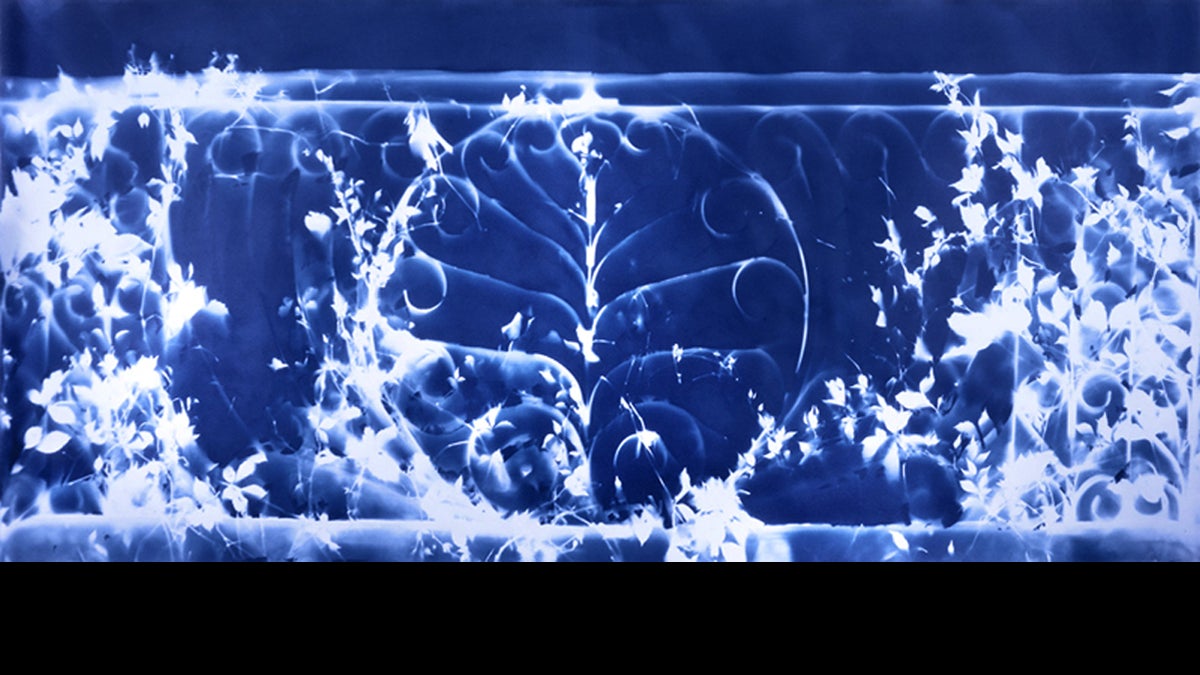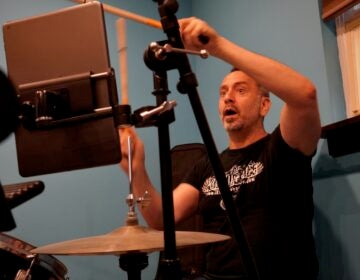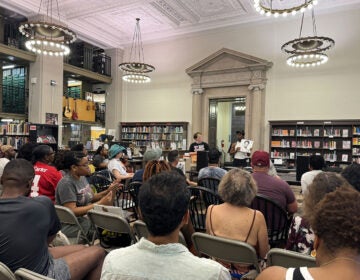Philadelphia’s Print Center celebrates a century

Martha Madigan's Falls Bridge, 1981, is a life-size solar photogram of the East Falls Bridge railing covered with weeds. (Image courtesy of Martha Madigan)CyanotypeCourtesy of the artist
The Print Center in Philadelphia has given over half of its second-floor exhibition space on Latimer Street to artist Gabriel Martinez.
A darkened room is installed with rotating disco balls reflecting a projection of Wakefield Poole’s “Boys in the Sand,” a 1971 film about a series of sexual encounters on Fire Island.
It was the first gay porn film to find mainstream, theatrical success, a year before “Deep Throat” made pornography semi-acceptable. Using illuminated stills from the film, and his own multi-layered photographic prints, Martinez’s “Bayside Revisited” is a paean to the Fire Island gay scene, then and now.
“His focus is on history in a very personal way, in a very poignant and charged way,” said Print Center curator John Caperton. “We thought it was a great way to think about how we are pushing our history, and also being very forward thinking.”
The Print Center has turned 100, and it wants to show where it has been, and where it expects to go. Since its founding in 1915, the Print Center has pushed to keep printmaking apace with contemporary art.
For years, Caperton has been challenging the notion that printmaking is an 8-by-11 black and white image framed on a wall. The Martinez installation is an immersive experience of light, image, and space.
Another part of the centenary show (which, for the record, has plenty of 8-by-11 framed black and white images) includes a four-channel video display and a large solar photogram by Martha Madigan from 1981, showing a life-size exposure of the East Falls Bridge railing, covered with weeds.
“A work like that is central to the mission of this organization,” said Caperton. “It’s both incredibly ambitious and very much tied to the history of photography.”
Downstairs, the exhibition is more historical, featuring highlights from the Print Center’s past, including items from the Works Progress Administration of the 1930s, and the Prints in Progress education program of the 1970s, a program that spurred other major printmaking programs — the Brandywine Workshop and the Fabric Workshop and Museum.
For 100 years, the Print Center has been an integral part of the Philadelphia art scene. Its growing collection of more than 1,700 prints is held by the Philadelphia Museum of Art, which has been represented on the Print Center’s board since the 1940s. The center also enjoys close, long-term relationships with the University of the Arts and the Free Library.
“In 1915 a group of collectors and artists came together to support what had been an underappreciated and marginalized medium. It really needed supporting,” said director Elizabeth Spungen. “Through 100 years, we have seen a change in that. We don’t have an art medium that needs bolstering, but a media that is at the center of conversations of contemporary art.”
More than 50 organizations across the city and across the country are helping the Print Center celebrate its centenary, including the Philadelphia Museum of Art, the Brooklyn Art Museum and the University of Chicago.
WHYY is your source for fact-based, in-depth journalism and information. As a nonprofit organization, we rely on financial support from readers like you. Please give today.





